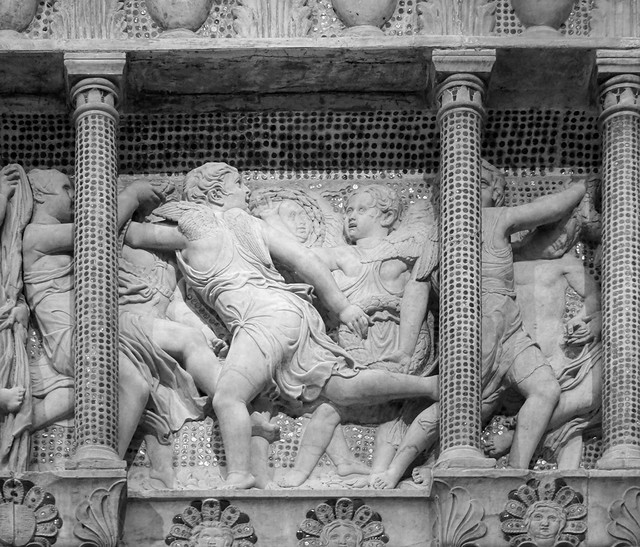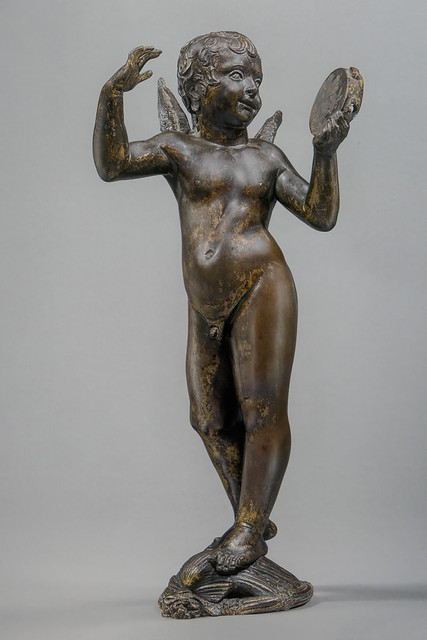Dancing Angels: Donatello’s Renaissance Spiritelli
Primary tabs
Spiritelli: Sacred Joy and Classical Vitality

Among the most captivating creations of the early Renaissance are the spiritelli—the winged, dancing, laughing bronze children of Donatello. These small figures, generally 40–100 centimeters in height, populate pulpits, fonts, tombs, and private interiors across fifteenth-century Tuscany. Though diminutive, they embody the Renaissance transformation of sculpture from static devotion to living movement, bridging the worlds of antiquity and Christianity, sacred ritual and humanist delight.
Donatello’s spiritelli did not emerge from fantasy. They are deeply rooted in his study of ancient Roman sarcophagi and small bronzes, where processions of putti—nude or draped children—carried garlands or danced in Bacchic celebration. In antiquity these figures symbolized life, renewal, and the eternal cycle of nature, often adorning tombs as emblems of immortality. Donatello revived this classical type, but reinterpreted it through a Christian and humanist lens. His spiritelli retained the ancient joy and movement of the putto, yet became expressions of divine vitality, the joy of heaven made visible in the exuberance of the human body.
The Spiritello Tambourine Player: Joy and Baptismal Renewal

At the Siena Baptistery, Donatello’s Spiritello with Tambourine took on sacred meaning. Cast around 1429–1432 as part of the font ensemble, the figure stands lightly on one foot, tambourine raised in rhythmic praise. Its pose is a dance of spiritual elation, perfectly suited to the Baptistery’s atmosphere of cleansing and rebirth.
Here, the ancient motif of the dancing putto is reborn as a Christian emblem of divine joy. The tambourine, once associated with Bacchic revelry, now becomes an instrument of heavenly music—the sound of the soul rejoicing in redemption. In this sacred context, Donatello fused antique vitality with liturgical symbolism, embodying the Renaissance conviction that the beauty of creation could reveal the glory of God.
The Seated Spiritelli: Music and Devotion in Florence Cathedral
![]()
![]()
The pair of seated, winged spiritelli originally from Santa Maria del Fiore (Florence Cathedral) extend this idea of sacred joy into the musical realm. Likely associated with Donatello’s Cantoria (singing gallery), they show plump, laughing children, poised as if caught mid-song or at play.
Their rounded forms and naturalistic gestures create a sense of intimacy and movement, perfectly attuned to the Cantoria’s theme—“Praise Him with timbrel and dance.” These spiritelli served both decorative and theological functions: they visually enacted the Psalms, turning stone and bronze into living praise. Their small scale and expressive detail demonstrate how Donatello could animate even the grandest architecture with human warmth and divine exuberance.
The Dancing Spiritello: From Sacred Ritual to Humanist Collection
![]()
The elegant Dancing Spiritello, later part of the Medici Grand Ducal collection, reveals how Donatello’s creations transcended their religious origins. Standing with one leg delicately crossed, one arm raised in rhythmic grace, this figure embodies the pure beauty of movement.
Detached from liturgical purpose, it became a symbol of artistic and humanist refinement—a perfect fusion of naturalism, classical poise, and expressive animation. For the Medici, whose collections celebrated both art and intellect, such a bronze was more than a charming ornament: it was a statement of cultural lineage, linking Florence’s present glory to the classical past.
A Language of Movement and Meaning
Across these contexts—the Bartolini palace, Siena’s Baptistery, Florence Cathedral, and the Medici collection—Donatello’s spiritelli reveal the extraordinary adaptability of the type. Their scale, typically between forty and sixty centimeters, was ideal for architectural integration and intimate viewing alike. Whether perched on pulpits, adorning fonts, or gracing domestic interiors, they transformed static structures into living processions of light and rhythm.
In Donatello’s hands, the small bronze figure became a microcosm of Renaissance thought: the union of body and spirit, the fusion of pagan antiquity and Christian truth, the translation of cosmic harmony into human form. Their laughter, dance, and music gave visible shape to the central Renaissance conviction that the divine could be found in the beauty of movement and the joy of life itself.
Legacy and Influence
Donatello’s spiritelli established the foundation for one of the most enduring visual languages in Western art. His pupils and successors—Luca della Robbia, Verrocchio, and later Riccio and Giambologna—adapted these childlike figures to every medium, from glazed terracotta to monumental bronze. The cherubs of Raphael’s Sistine Madonna and the athletic youths of Michelangelo’s Sistine Ceiling continue this lineage, translating Donatello’s animated innocence into new expressions of divine and human beauty.
Through these bronzes, Donatello transformed the ancient putto into a Renaissance ideal: a being of joy, intelligence, and sacred vitality. Whether dancing in a cathedral, singing in marble relief, or smiling from a collector’s cabinet, his spiritelli remind us that the Renaissance was not only a rebirth of classical form—but a celebration of life itself.
